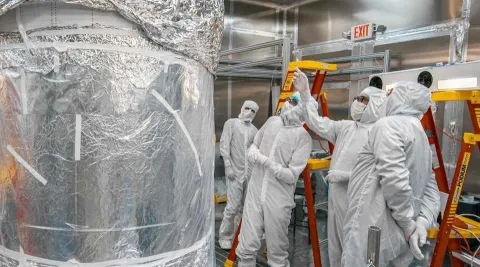The Search for Dark Matter
What is dark matter and why is it so hard to find? Learn about scientific phenomena supporting the dark matter theory, explore matter and its interactions, and join the global search for dark matter.
Curriculum module media

The LUX-Zeppelin Dark Matter Detector under construction at SURF. Photo by Nick Hubbard
Many scientists are convinced that the vast majority of the matter in the universe is invisible; perhaps containing five times more dark matter than ordinary matter. However, because dark matter does not reveal its presence by emitting any type of electromagnetic radiation, visible proof of its existence is elusive.
By following the dark mater evidence chronologically, students will explore matter and its interactions. They will also learn about the scientists and technologies that made new discoveries possible. Finally students are introduced to the search for dark matter taking place at the Sanford Underground Research Facility.
The Search For Dark Matter